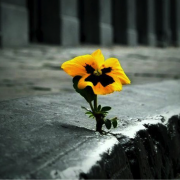The Hidden Meaning in Our Garden
From time to time, we think our life is on a knife edge. We have experienced very vividly in the last three months that anything can happen at any moment. However, despite all the chaos, our life hangs not on by a thread but on two magical elements: “positive social relationships” and “sense of meaning and purpose in life.” According to 75 years of happiness research at Harvard University, the strong social relationships we have and conduct render us healthy and happy. On the other hand, according to the meaning and purpose researches having been conducted for 60 years, it has been revealed that those with meaning and purpose are much more resilient, able to cope with difficulties, adapt to difficult conditions and survive. The interesting part is that the sense of meaning and purpose emerges in difficult situations; and it serves to survive by protection… The common point of the survivors of the Holocaust in the Second World War is that they, undoubtedly, found meaning and purpose to exist despite their circumstances.
When I look at the situations, we have been through for the last three months, compared to previous periods, we are being tested, so to speak, in terms of social relations, meaning and purpose… Each of us has made progress in his way. Despite the social distance, we have developed our social ties; despite the distance, we have created much closer and deeper relationships than ever before… In the face of the situation we are in, we have diversified our attitudes and behaviors to the extent of the current difficulties and our abilities… Besides being obsessed, anxious, or biased towards events and facts, we have trained ourselves to look at things objectively… Many of us have been immersed in new habits, pursuits, or trials; we have begun to acquire new meanings and purposes… We increased our resilience skills by adapting to uncertain and temporal conditions… By means of all this, I believe we can come out of the Covid-19 wave as healthy and peaceful as possible… In fact, we are ready for the aforementioned second wave –which I hope not, physically, mentally and psychologically in a more balanced and robust state.
So we did all that, was it easy? Of course not! We have made a great effort… It’s not easy to have meaning and purpose in life, to find it, or to obtain it, especially when you’re going through such difficult time, but as we can see, it’s possible… Based on the story of a young man seeking the meaning of life, let me tell you how it is made possible… The story takes place in Paulo Coelho’s book The Alchemist…
One fine day, a young man who seeks the meaning of life goes to the elder sage of the village and asks about meaning of life. The sage begins with saying, “I’ll give you the answer, but first you have to take this test”; then hands him over a spoonful of olive oil and instructs him, “go out now, tour around the garden, and come back here… but… be careful; the olive oil on the spoon should not lessen!”
The young man does what the wise man says; soon he comes back with a smile of success… not even a drop of the oil was lacking! The sage says, “bravo, my son, there is no shortage” and, “what did you see in the garden?” he asks. The young man just says, “I didn’t look anywhere but the spoon!” The wise man sends him again to walk around the garden, to examine the garden; with the same spoon… Soon, the young man returns to the sage fascinated and describes the beauties he had seen in the garden… Nevertheless, there is no oil left in the spoon… The wise man smiles and says, “The meaning of life is hidden in your gaze. Life becomes meaningful with your look…” If you focus on just one point, your life goes by and you don’t even realize it… Yet what a waste it is… not to see all the beauty that you could ever see while you’re living in it! What gives meaning to life is to see what is around you, to make the best of its beauties, and to get the wealth of life from it, even when you’re focused on the goal…”
So how do we do it? You might be wondering; how you can manage to see what’s happening in your garden while at the same time being focused on your objectives… Well, it is by training your mind… Occasionally, by following these small steps: (1) pausing for a moment; (2) drawing your attention from the work you are doing; (3) closing your eyes, taking a breath; (4) opening your eyes again and looking around with curiosity… (5) remembering once again where you are, what you are doing, and why you are doing what you’re doing… and perhaps (6) looking for new answers to your “why”… Whatever you need, whether refreshing the available or looking for a new meaning and purpose, everything you look at and see with a new eye will give you clues to the meaning and purpose of your life, that is “raison d’étre” -your reason to live!
Those who have a reason to live, can bear almost any “how”, says Nietzsche. When we find the why in life, we can easily construct the how. In spite of the inevitable suffering, Viktor Frankl says that we can capture happiness by making our lives meaningful… He says that obtaining meaning and purpose are not as far away and as inaccessible as one might think; on the contrary, there are different ways to make life meaningful; and that we can create meaning by (1) creating a work or doing a job; (2) having an experience or interacting with someone; or (3) recultivating an attitude to inevitable pain…
In short, although our meaning and purpose seem to be in the olive oil in our spoons, as we continue our lives focused on the goal in this period of revival and return to life, they are essentially hidden in our garden… Hidden in what we go through as we move towards our objectives, hidden in what we experience… and hidden in the attitudes we develop in the face of phenomenon…
Dr. Shirli Ender Büyükbay
June 3, 2020














